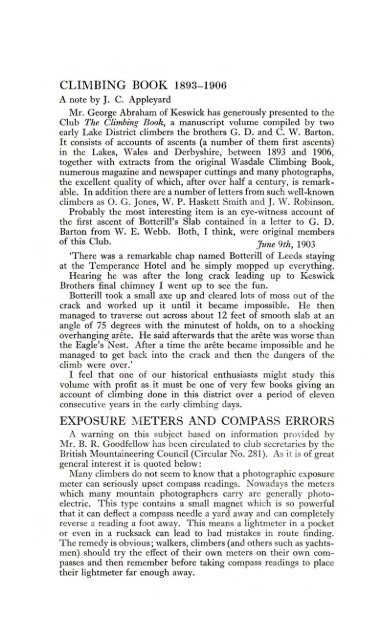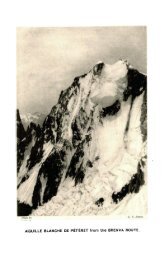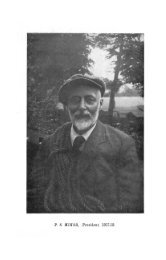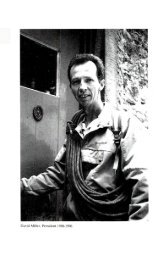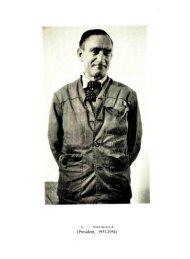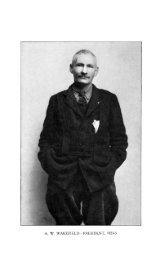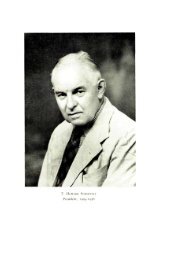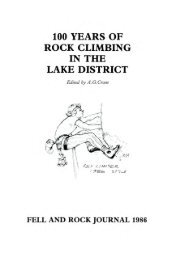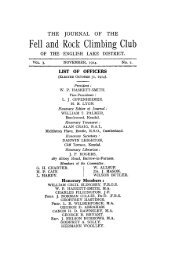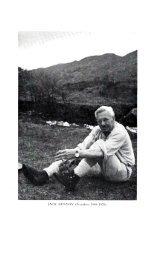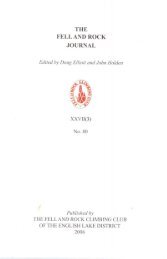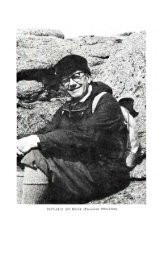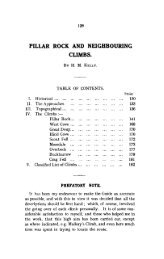Year of publication 1960 - Fell and Rock Climbing Club
Year of publication 1960 - Fell and Rock Climbing Club
Year of publication 1960 - Fell and Rock Climbing Club
Create successful ePaper yourself
Turn your PDF publications into a flip-book with our unique Google optimized e-Paper software.
CLIMBING BOOK 1893-1906A note by J. C. AppleyardMr. George Abraham <strong>of</strong> Keswick has generously presented to the<strong>Club</strong> The <strong>Climbing</strong> Book, a manuscript volume compiled by twoearly Lake District climbers the brothers G. D. <strong>and</strong> C. W. Barton.It consists <strong>of</strong> accounts <strong>of</strong> ascents (a number <strong>of</strong> them first ascents)in the Lakes, Wales <strong>and</strong> Derbyshire, between 1893 <strong>and</strong> 1906,together with extracts from the original Wasdale <strong>Climbing</strong> Book,numerous magazine <strong>and</strong> newspaper cuttings <strong>and</strong> many photographs,the excellent quality <strong>of</strong> which, after over half a century, is remarkable.In addition there are a number <strong>of</strong> letters from such well-knownclimbers as O. G. Jones, W. P. Haskett Smith <strong>and</strong> J. W. Robinson.Probably the most interesting item is an eye-witness account <strong>of</strong>the first ascent <strong>of</strong> Botterill's Slab contained in a letter to G. D.Barton from W. E. Webb. Both, I think, were original members<strong>of</strong> this <strong>Club</strong>. j u n e 9th> 1903'There was a remarkable chap named Botterill <strong>of</strong> Leeds stayingat the Temperance Hotel <strong>and</strong> he simply mopped up everything.Hearing he was after the long crack leading up to KeswickBrothers final chimney I went up to see the fun.Botterill took a small axe up <strong>and</strong> cleared lots <strong>of</strong> moss out <strong>of</strong> thecrack <strong>and</strong> worked up it until it became impossible. He thenmanaged to traverse out across about 12 feet <strong>of</strong> smooth slab at anangle <strong>of</strong> 75 degrees with the minutest <strong>of</strong> holds, on to a shockingoverhanging arete. He said afterwards that the arete was worse thanthe Eagle's Nest. After a time the arete became impossible <strong>and</strong> hemanaged to get back into the crack <strong>and</strong> then the dangers <strong>of</strong> theclimb were over.'I feel that one <strong>of</strong> our historical enthusiasts might study thisvolume with pr<strong>of</strong>it as it must be one <strong>of</strong> very few books giving anaccount <strong>of</strong> climbing done in this district over a period <strong>of</strong> elevenconsecutive years in the early climbing days.EXPOSURE METERS AND COMPASS ERRORSA warning on this subject based on information provided byMr. B. R. Goodfellow has been circulated to club secretaries by theBritish Mountaineering Council (Circular No. 281). As it is <strong>of</strong> greatgeneral interest it is quoted below:Many climbers do not seem to know that a photographic exposuremeter can seriously upset compass readings. Nowadays the meterswhich many mountain photographers carry are generally photoelectric.This type contains a small magnet which is so powerfulthat it can deflect a compass needle a yard away <strong>and</strong> can completelyreverse a reading a foot away. This means a lightmeter in a pocketor even in a rucksack can lead to bad mistakes in route finding.The remedy is obvious; walkers, climbers (<strong>and</strong> others such as yachtsmen)should try the effect <strong>of</strong> their own meters on their own compasses<strong>and</strong> then remember before taking compass readings to placetheir lightmeter far enough away.


